Seasonal Variations of High-Frequency Gravity Wave Momentum Fluxes and Their Forcing toward Zonal Winds in the Mesosphere and Lower Thermosphere over Langfang, China (39.4° N, 116.7° E)
Abstract
:1. Introduction
2. Data and Analysis Method
2.1. Momentum Flux Determination
2.2. Estimation of Mean Flow Acceleration
3. Observations and Results
3.1. Momentum Flux of GW and its Seasonal Variation
3.2. Observation and Estimation of Semi-Annual Oscillation Mean Flow Acceleration
3.3. Observation and Estimation of Quasi-4-Month Oscillation Mean Flow Acceleration
4. Discussion
4.1. Error Analysis
4.1.1. Momentum Flux Determination
4.1.2. Meteor Statistics
4.2. Seasonal Variation of GW Momentum Flux
4.3. Mean Flow Acceleration
5. Conclusions
Author Contributions
Funding
Acknowledgments
Conflicts of Interest
References
- Taylor, M.J.; Hapgood, M.A. Identification of a thunderstorm as a source of short period gravity waves in the upper atmospheric nightglow emissions. Planet. Space Sci. 1988, 36, 975–985. [Google Scholar] [CrossRef]
- Lindzen, R.S. Turbulence and stress owing to gravity-wave and tidal breakdown. J. Geophys. Res. 1981, 86, 9707–9714. [Google Scholar] [CrossRef] [Green Version]
- Fritts, D.C.; Vincent, R.A. Mesospheric momentum flux studies at adelaide, australia: Observations and a gravity wave–tidal interaction model. J. Atmos. Sci. 1987, 44, 605–619. [Google Scholar] [CrossRef] [Green Version]
- Geller, M.A.; Alexander, M.J.; Love, P.T.; Bacmeister, J.; Ern, M.; Hertzog, A.; Manzini, E.; Preusse, P.; Sato, K.; Scaife, A.A.; et al. A comparison between gravity wave momentum fluxes in observations and climate models. J. Clim. 2013, 26, 6383–6405. [Google Scholar] [CrossRef] [Green Version]
- Placke, M.; Hoffmann, P.; Latteck, R.; Rapp, M. Gravity wave momentum fluxes from MF and meteor radar measurements in the polar MLT region. Geophys. Res. Space 2015, 120, 736–750. [Google Scholar] [CrossRef] [Green Version]
- Suzuki, S.; Shiokawa, K.; Otsuka, Y.; Ogawa, T.; Kubota, M.; Tsutsumi, M.; Nakamura, T.; Fritts, D.C. Gravity wave momentum flux in the upper mesosphere derived from oh airglow imaging measurements. Earth Planets Space 2007, 59, 421–428. [Google Scholar] [CrossRef] [Green Version]
- Espy, P.J.; Jones, G.O.L.; Swenson, G.R.; Tang, J.; Taylor, M.J. Seasonal variations of the gravity wave momentum flux in the antarctic mesosphere and lower thermosphere. J. Geophys. Res. 2004, 109, D23109. [Google Scholar] [CrossRef] [Green Version]
- Acott, P.E.; She, C.-Y.; Krueger, D.A.; Yan, Z.-A.; Yuan, T.; Yue, J.; Harrell, S. Observed nocturnal gravity wave variances and zonal momentum flux in mid-latitude mesopause region over Fort Collins, Colorado, USA. J. Atmos. Sol. Terr. Phys. 2011, 73, 449–456. [Google Scholar] [CrossRef]
- Li, T.; Ban, C.; Fang, X.; Li, J.; Wu, Z.; Feng, W.; Plane, J.M.C.; Xiong, J.; Marsh, D.R.; Mills, M.J.; et al. Climatology of mesopause region nocturnal temperature, zonal wind, and sodium density observed by sodium lidar over Hefei, China (32° N, 117° E). Atmos. Chem. Phys. 2018, 18, 11683–11695. [Google Scholar] [CrossRef] [Green Version]
- Hocking, W.K. A new approach to momentum flux determinations using SKiYMET meteor radars. Ann. Geophys. 2005, 23, 2433–2439. [Google Scholar] [CrossRef] [Green Version]
- Antonita, T.M.; Ramkumar, G.; Kumar, K.K.; Deepa, V. Meteor wind radar observations of gravity wave momentum fluxes and their forcing toward the mesospheric semiannual oscillation. J. Geophys. Res. Atmos. 2008, 113. [Google Scholar] [CrossRef] [Green Version]
- Placke, M.; Hoffmann, P.; Becker, E.; Jacobi, C.; Singer, W.; Rapp, M. Gravity wave momentum fluxes in the MLT—Part II: Meteor radar investigations at high and midlatitudes in comparison with modeling studies. J. Atmos. Sol. Terr. Phys.. 2011, 73, 911–920. [Google Scholar] [CrossRef]
- Placke, M.; Stober, G.; Jacobi, C. Gravity wave momentum fluxes in the MLT—Part I: Seasonal variation at Collm (51.3° N, 13.0° E). J. Atmos. Sol. Terr. Phys. 2011, 73, 904–910. [Google Scholar] [CrossRef]
- Liu, A.Z.; Lu, X.; Franke, S.J. Diurnal variation of gravity wave momentum flux and its forcing on the diurnal tide. J. Geophys. Res. Atmos. 2013, 118, 1668–1678. [Google Scholar] [CrossRef] [Green Version]
- Andrioli, V.F.; Batista, P.P.; Clemesha, B.R.; Schuch, N.J.; Buriti, R.A. Multi-year observations of gravity wave momentum fluxes at low and middle latitudes inferred by all-sky meteor radar. Ann. Geophys. 2015, 33, 1183–1193. [Google Scholar] [CrossRef] [Green Version]
- de Wit, R.J.; Hibbins, R.E.; Espy, P.J.; Orsolini, Y.J.; Limpasuvan, V.; Kinnison, D.E. Observations of gravity wave forcing of the mesopause region during the January 2013 major Sudden Stratospheric Warming. Geophys. Res. Lett. 2014, 41, 4745–4752. [Google Scholar] [CrossRef] [Green Version]
- De Wit, R.; Hibbins, R.; Espy, P.J. The seasonal cycle of gravity wave momentum flux and forcing in the high latitude northern hemisphere mesopause region. J. Atmos. Sol. Terr. Phys. 2015, 127, 21–29. [Google Scholar] [CrossRef]
- Moss, A.C.; Wright, C.J.; Davis, R.N.; Mitchell, N.J. Gravity-wave momentum fluxes in the mesosphere over Ascension Island (8° S, 14° W) and the anomalous zonal winds of the semi-annual oscillation in 2002. Ann. Geophys. 2016, 34, 323–330. [Google Scholar] [CrossRef] [Green Version]
- Matsumoto, N.; Shinbori, A.; Riggin, D.M.; Tsuda, T. Measurement of momentum flux using two meteor radars in Indonesia. Ann. Geophys. 2016, 34, 369–377. [Google Scholar] [CrossRef] [Green Version]
- Jia, M.; Xue, X.; Gu, S.-Y.; Chen, T.; Ning, B.; Wu, J.; Zeng, X.; Dou, X.; Mingjiao, J.; Xianghui, X.; et al. Multi-year observations of gravity wave momentum fluxes in the mid-latitude mesosphere and lower thermosphere region by meteor radar. J. Geophys. Res. Space Phys. 2018, 123, 5684–5703. [Google Scholar] [CrossRef] [Green Version]
- Pramitha, M.; Kumar, K.K.; Ratnam, M.V.; Rao, S.V.B.; Ramkumar, G. Meteor radar estimations of gravity wave momentum fluxes: Evaluation using simulations and observations over three tropical locations. J. Geophys. Res. Space Phys. 2019, 124, 7184–7201. [Google Scholar] [CrossRef]
- de Wit, R.J.; Janches, D.; Fritts, D.C.; Hibbins, R.E. QBO modulation of the mesopause gravity wave momentum flux over Tierra del Fuego. Geophys. Res. Lett. 2016, 43, 4049–4055. [Google Scholar] [CrossRef] [Green Version]
- Chen, X. Researches on the Variations of the Mesospheric and Thermospheric Atmosphere; Degree-University of Chinese Academy of Sciences: Beijing, China, 2013. [Google Scholar]
- Iimura, H.; Fritts, D.C.; Riggin, D.M. Long-term oscillations of the wind field in the tropical mesosphere and lower thermosphere from Hawaii MF radar measurements. J. Geophys. Res. Atmos. 2010, 115. [Google Scholar] [CrossRef]
- Andrioli, V.F.; Fritts, D.C.; Batista, P.P.; Clemesha, B.R. Improved analysis of all-sky meteor radar measurements of gravity wave variances and momentum fluxes. Ann. Geophys. 2013, 31, 889–908. [Google Scholar] [CrossRef] [Green Version]
- Fritts, D.C.; Janches, D.; Iimura, H.; Hocking, W.K.; Bageston, J.V.; Leme, N.M.P. Drake antarctic agile meteor radar first results: Configuration and comparison of mean and tidal wind and gravity wave momentum flux measurements with Southern Argentina Agile Meteor Radar. J. Geophys. Res. Atmos. 2012, 117, D02105. [Google Scholar] [CrossRef] [Green Version]
- Holdsworth, D.A.; Reid, I.M.; Cervera, M.A. Buckland Park all-sky interferometric meteor radar. Radio Sci. 2004, 39, RS5009. [Google Scholar] [CrossRef]
- Vincent, R.A.; Kovalam, S.; Reid, I.M.; Younger, J.P. Gravity wave flux retrievals using meteor radars. Geophys. Res. Lett. 2010, 37, 37. [Google Scholar] [CrossRef]
- Spargo, A.J.; Reid, I.M.; MacKinnon, A.D. Multistatic meteor radar observations of gravity-wave-tidal interaction over southern Australia. Atmos. Meas. Tech. 2019, 12, 4791–4812. [Google Scholar] [CrossRef] [Green Version]
- Fritts, D.C.; Alexander, M.J. Gravity wave dynamics and effects in the middle atmosphere. Rev. Geophys. 2003, 41. [Google Scholar] [CrossRef] [Green Version]
- Andrews, D.G.; Holton, J.R.; Leovy, C.B. Middle Atmosphere Dynamics; Academic Press: Orlando, FL, USA; San Diego, CA, USA; New York, NY, USA, 1987; pp. 8–128. [Google Scholar]
- Reid, I.M.; Vincent, R.A. Measurements of mesospheric gravity wave momentum fluxes and mean flow accelerations at Adelaide, Australia. J. Atmos. Sol. Terr. Phys. 1987, 49, 443–460. [Google Scholar] [CrossRef]
- Xiao, C.Y.; Hu, X. Analysis on the Global Morphology of Stratospheric Gravity Wave Activity Deduced from the COSMIC GPS Occultation Profiles. GPS Solut. 2010, 14, 65–74. [Google Scholar] [CrossRef]
- Tsuda, T.; Nishida, M.; Rocken, C.; Ware, R.H. A global morphology of gravity wave activity in the stratosphere revealed by the GPS occultation data (GPS/MET). J. Geophys. Res. Atmos. 2000, 105, 7257–7273. [Google Scholar] [CrossRef]
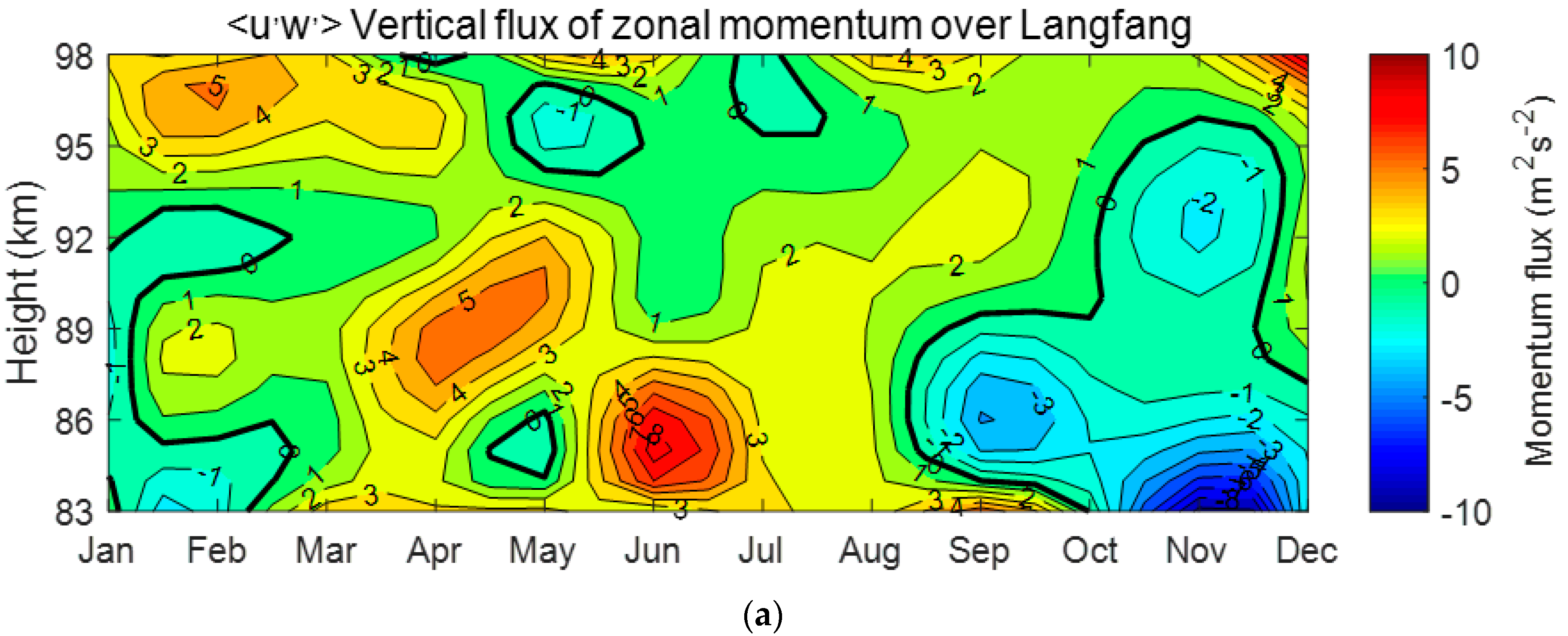
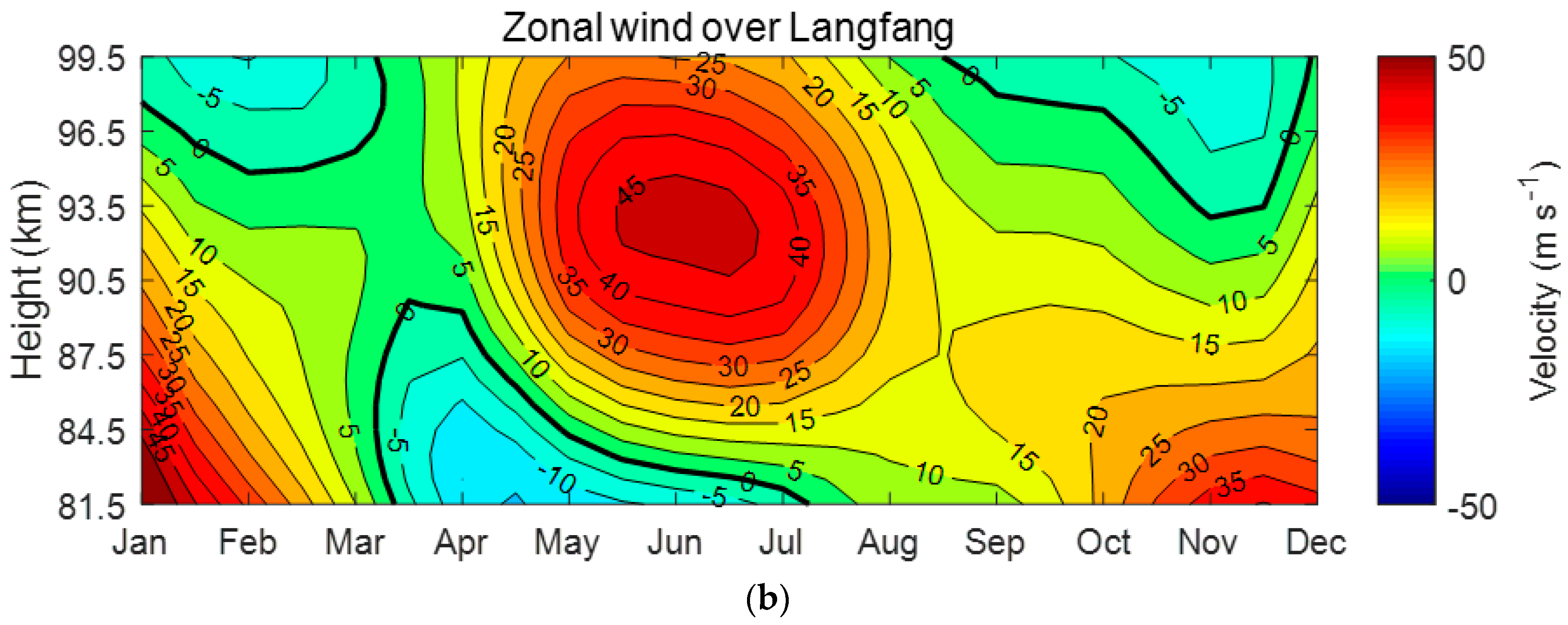
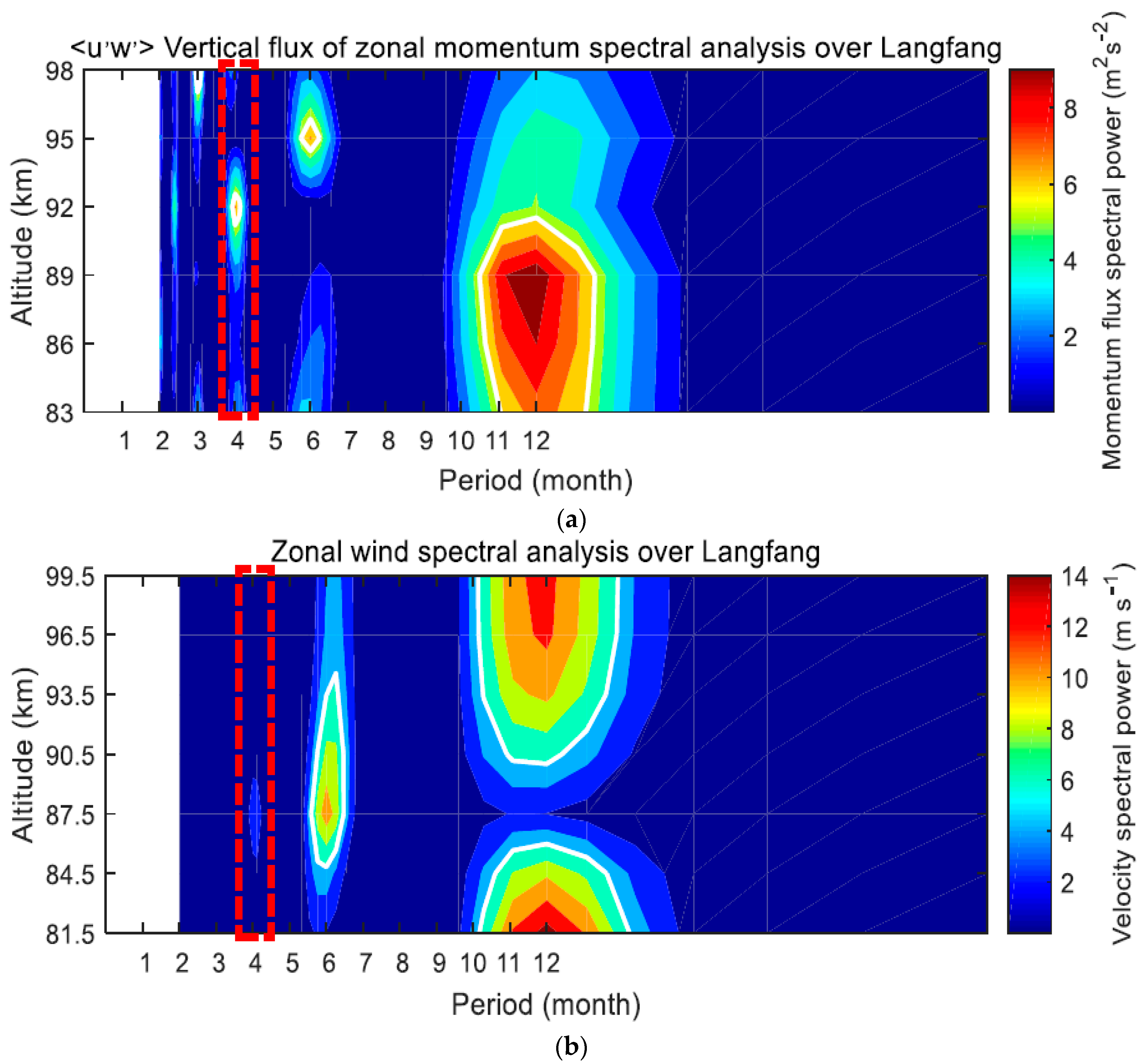

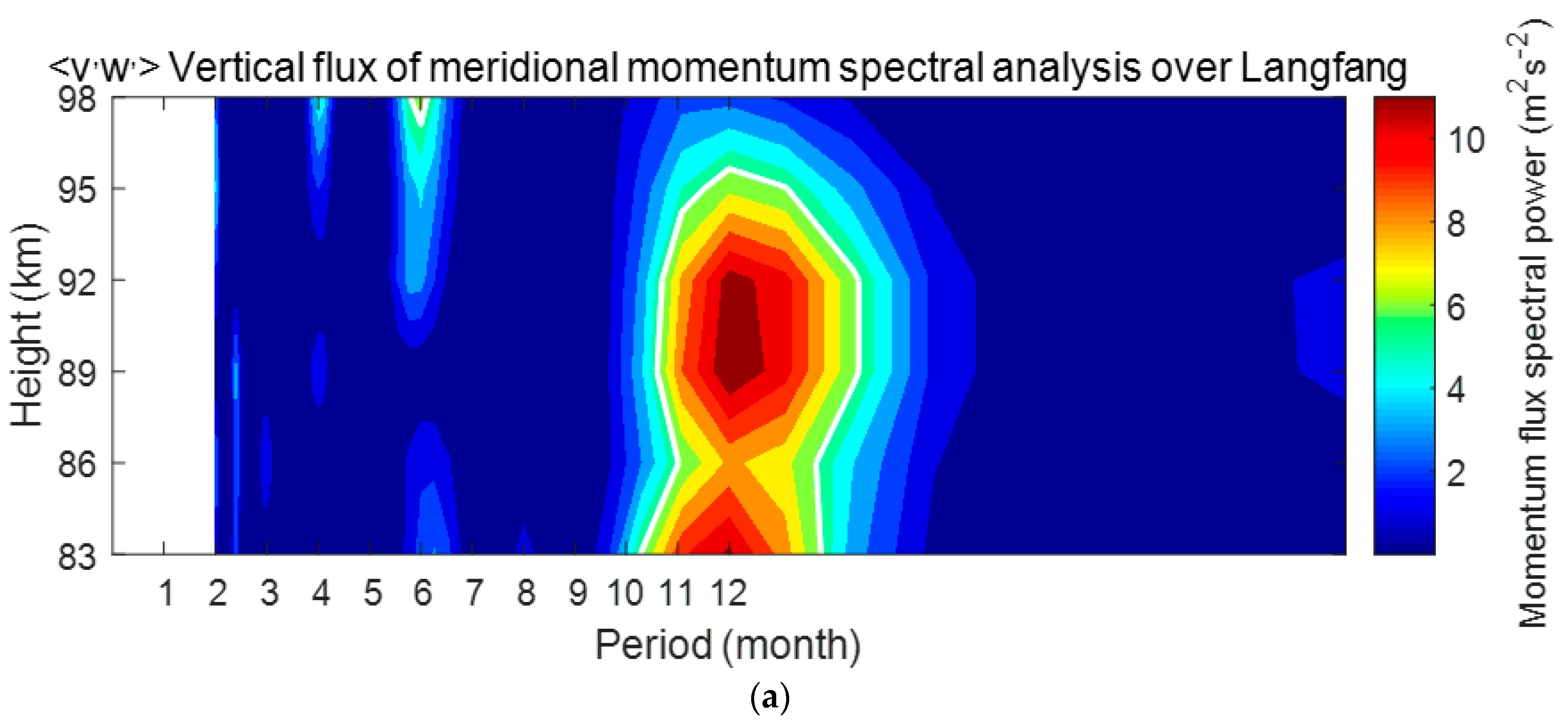
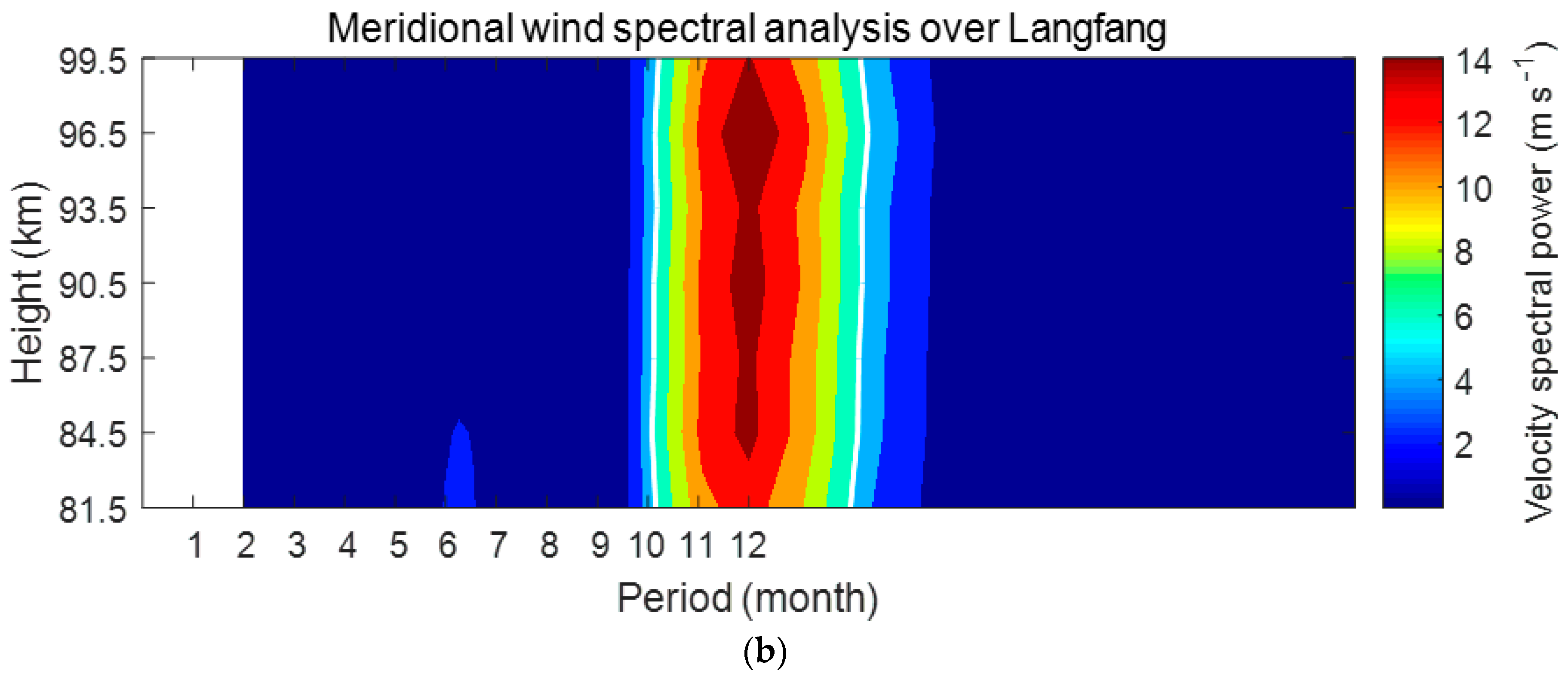
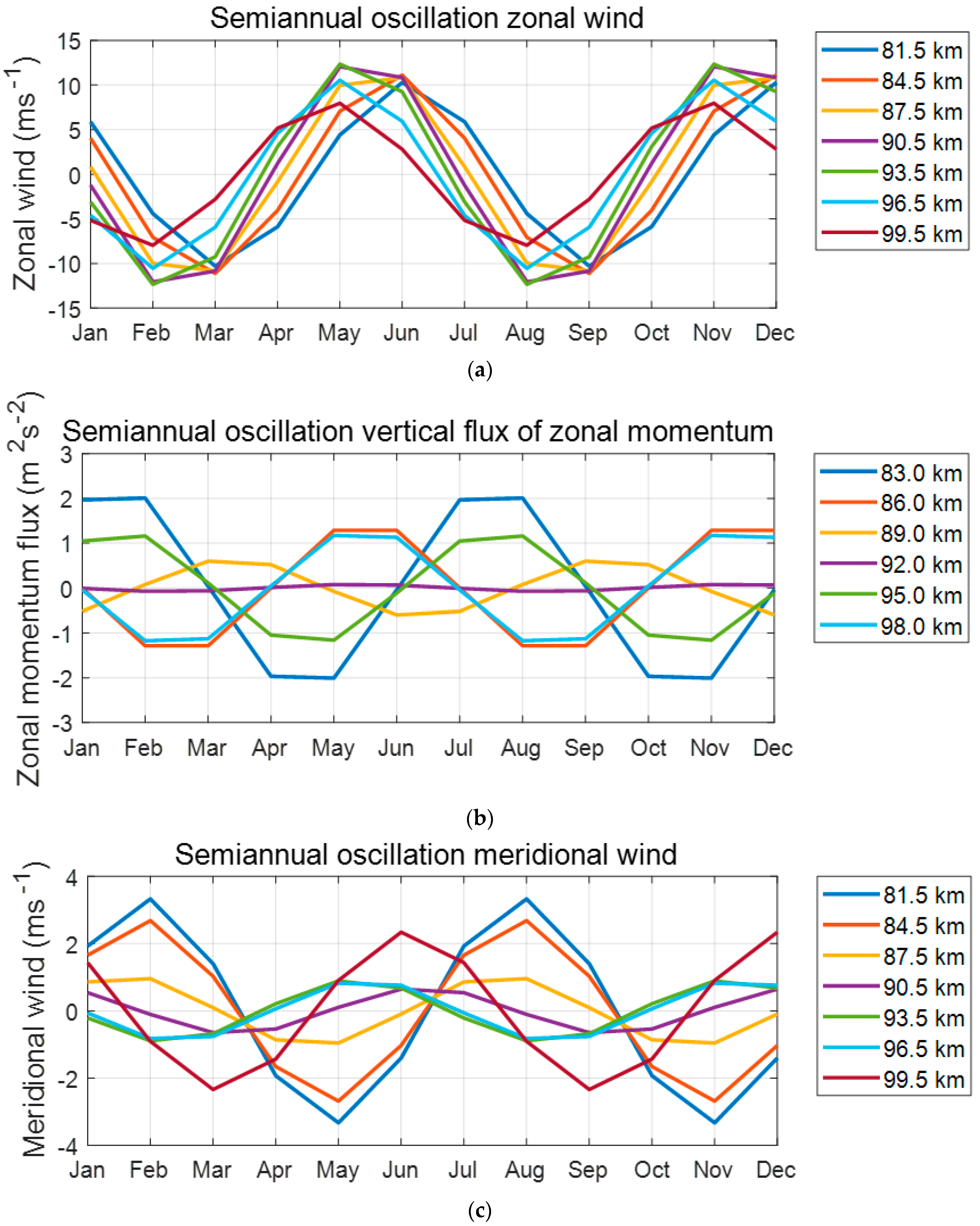
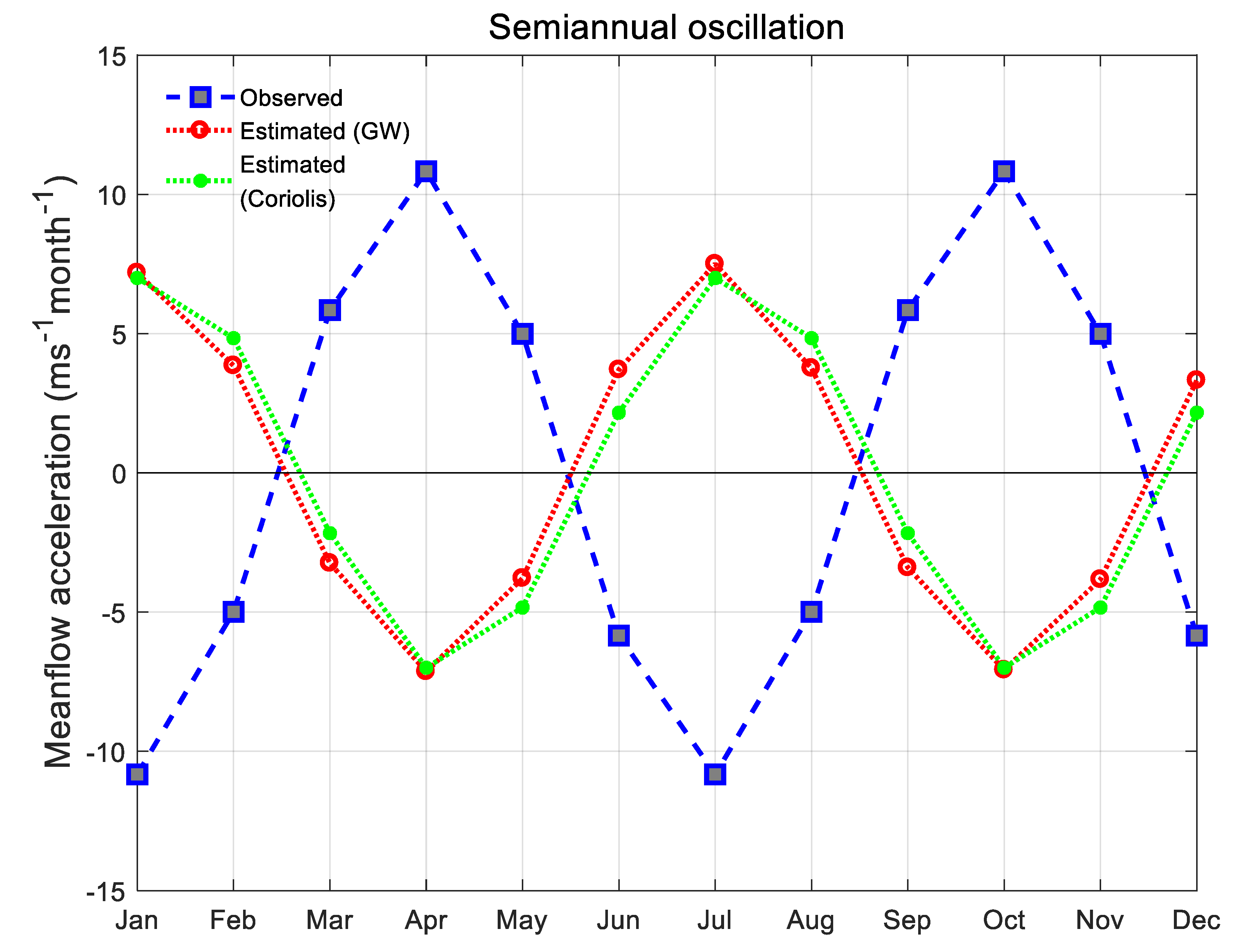
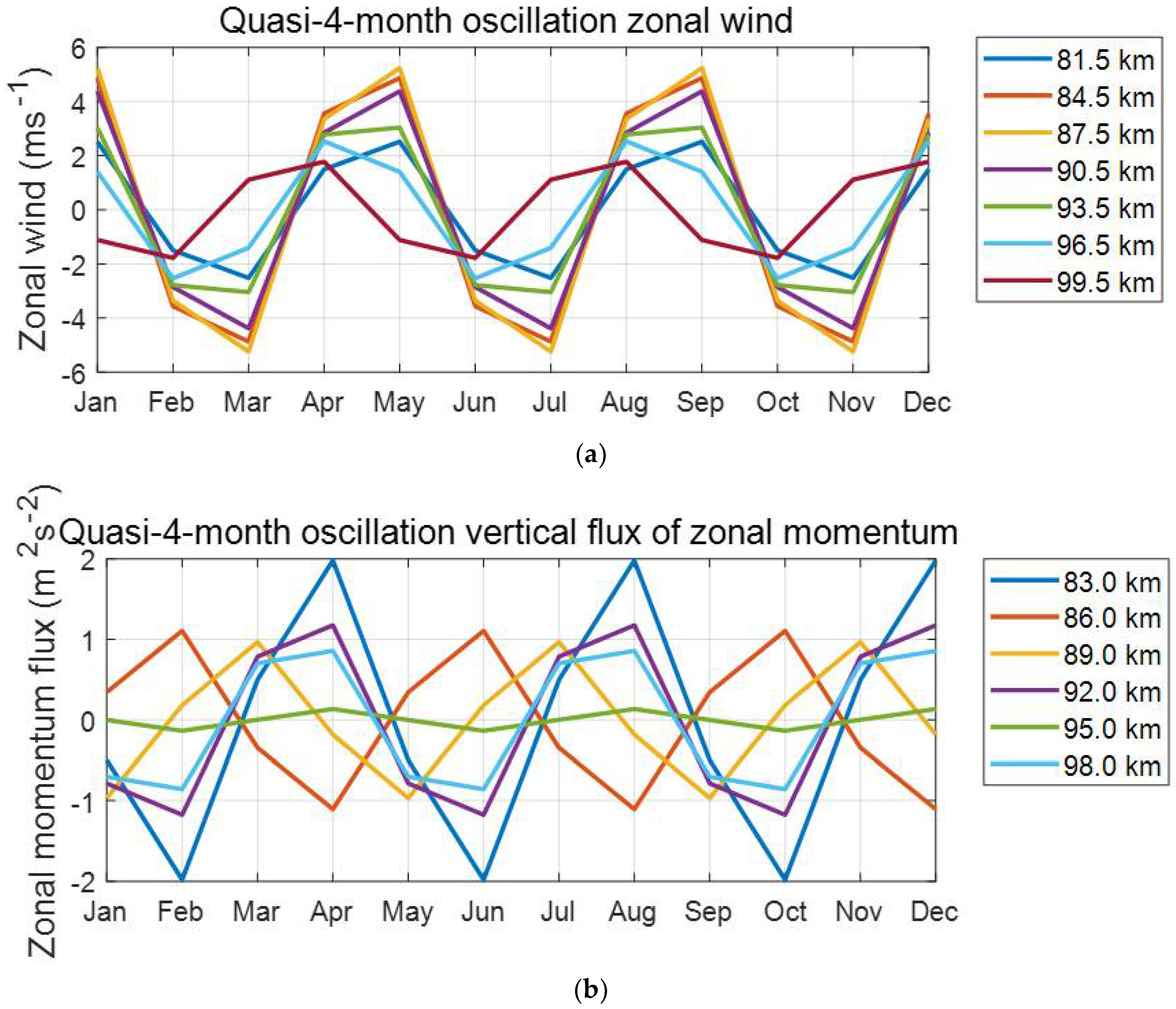
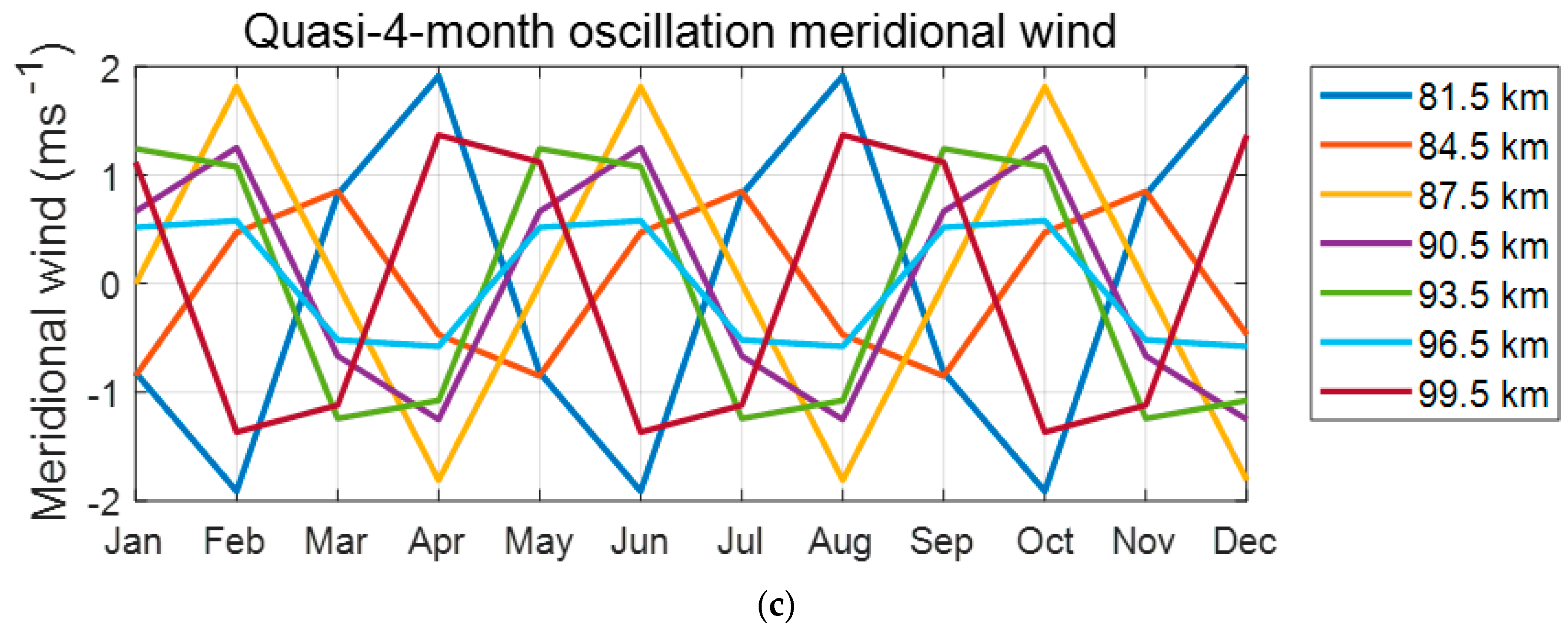
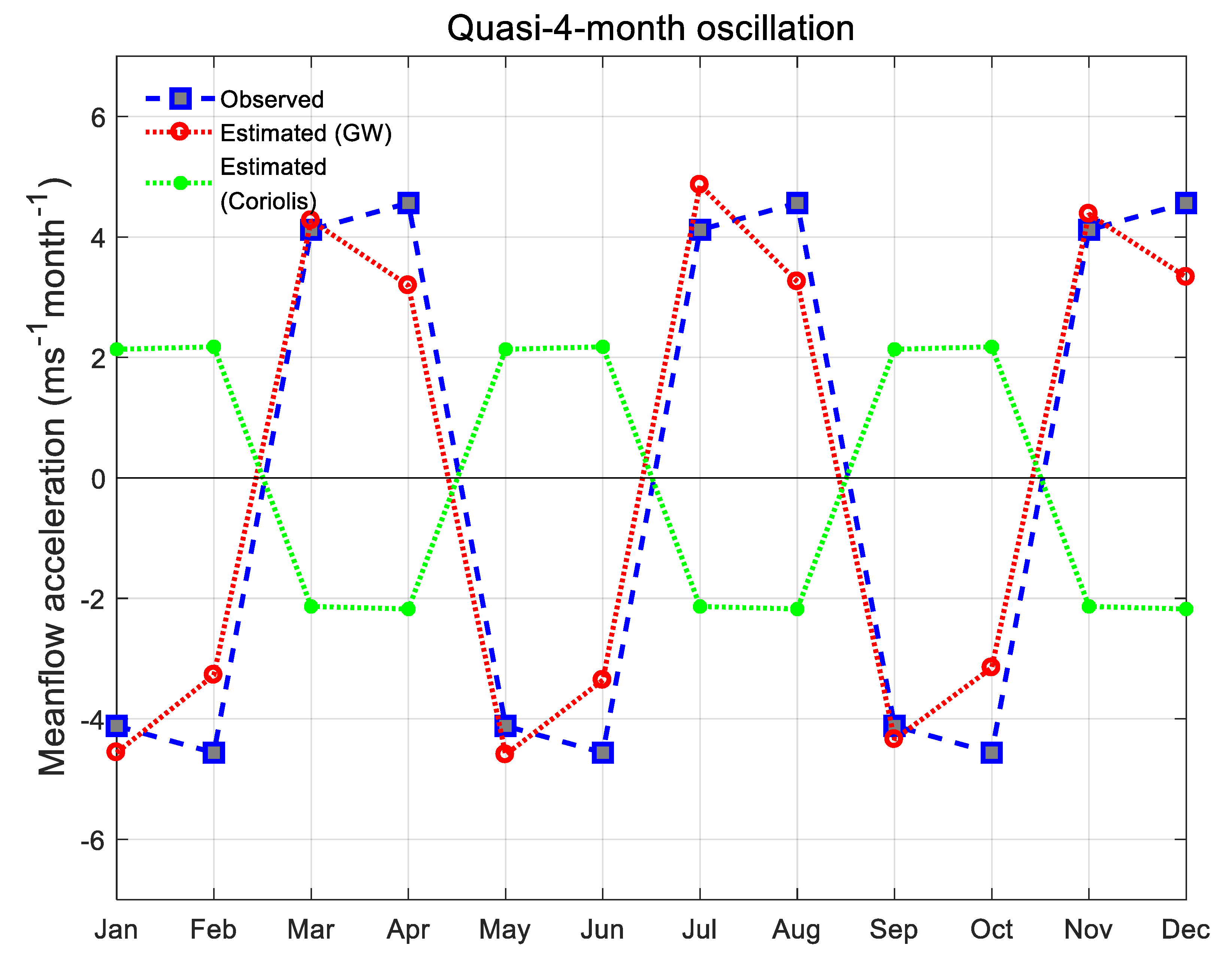

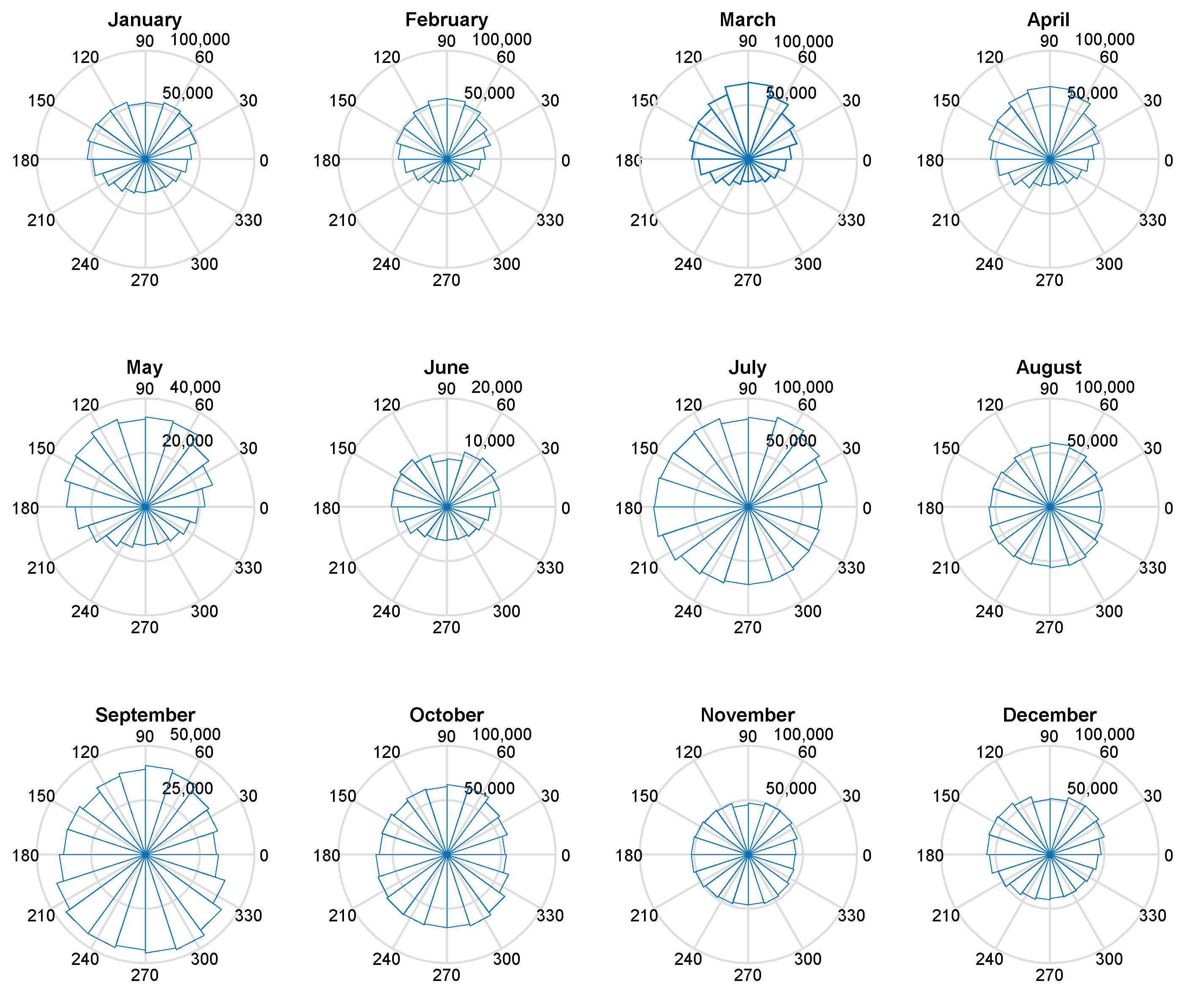
| Month | Observed Acceleration of SAO Zonal Wind | Estimated Acceleration from GW Momentum Fluxes | Estimated Acceleration due to Coriolis Force | Percentage of Contribution of GWs | Percentage of Contribution of Coriolis Force |
|---|---|---|---|---|---|
| January | −10.83 | 7.18 | 7.00 | −66.30% | −64.62% |
| February | −4.99 | 3.85 | 4.83 | −77.19% | −96.89% |
| March | 5.84 | −3.24 | −2.16 | −55.50% | −37.05% |
| April | 10.83 | −7.13 | −7.00 | −65.87% | −64.62% |
| May | 4.99 | −3.78 | −4.83 | −75.86% | −96.89% |
| June | −5.84 | 3.70 | 2.16 | −63.42% | −37.05% |
| July | −10.83 | 7.50 | 7.00 | −69.23% | −64.62% |
| August | −4.99 | 3.76 | 4.83 | −75.35% | −96.89% |
| September | 5.84 | −3.40 | −2.16 | −58.25% | −37.05% |
| October | 10.83 | −7.08 | −7.00 | −65.33% | −64.62% |
| November | 4.99 | −3.83 | −4.83 | −76.69% | −96.89% |
| December | −5.84 | 3.32 | 2.16 | −56.85% | −37.05% |
| Month | Observed Acceleration of Quasi-4-Month Oscillation Zonal Wind | Estimated Acceleration from GW Momentum Fluxes | Estimated Acceleration due to Coriolis Force | Percentage of Contribution of GWs | Percentage of Contribution of Coriolis Force |
|---|---|---|---|---|---|
| January | −4.12 | −4.56 | 2.13 | 110.76% | −51.84% |
| February | −4.56 | −3.27 | 2.18 | 71.73% | −47.69% |
| March | 4.12 | 4.27 | −2.13 | 103.74% | −51.84% |
| April | 4.56 | 3.19 | −2.18 | 69.97% | −47.69% |
| May | −4.12 | −4.59 | 2.13 | 111.57% | −51.84% |
| June | −4.56 | −3.36 | 2.18 | 73.58% | −47.69% |
| July | 4.12 | 4.86 | −2.13 | 118.06% | −51.84% |
| August | 4.56 | 3.26 | −2.18 | 71.39% | −47.69% |
| September | −4.12 | −4.34 | 2.13 | 105.44% | −51.84% |
| October | −4.56 | −3.15 | 2.18 | 69.06% | −47.69% |
| November | 4.12 | 4.38 | −2.13 | 106.38% | −51.84% |
| December | 4.56 | 3.33 | −2.18 | 73.03% | −47.69% |
Publisher’s Note: MDPI stays neutral with regard to jurisdictional claims in published maps and institutional affiliations. |
© 2020 by the authors. Licensee MDPI, Basel, Switzerland. This article is an open access article distributed under the terms and conditions of the Creative Commons Attribution (CC BY) license (http://creativecommons.org/licenses/by/4.0/).
Share and Cite
Tian, C.; Hu, X.; Liu, Y.; Cheng, X.; Yan, Z.; Cai, B. Seasonal Variations of High-Frequency Gravity Wave Momentum Fluxes and Their Forcing toward Zonal Winds in the Mesosphere and Lower Thermosphere over Langfang, China (39.4° N, 116.7° E). Atmosphere 2020, 11, 1253. https://doi.org/10.3390/atmos11111253
Tian C, Hu X, Liu Y, Cheng X, Yan Z, Cai B. Seasonal Variations of High-Frequency Gravity Wave Momentum Fluxes and Their Forcing toward Zonal Winds in the Mesosphere and Lower Thermosphere over Langfang, China (39.4° N, 116.7° E). Atmosphere. 2020; 11(11):1253. https://doi.org/10.3390/atmos11111253
Chicago/Turabian StyleTian, Caixia, Xiong Hu, Yurong Liu, Xuan Cheng, Zhaoai Yan, and Bing Cai. 2020. "Seasonal Variations of High-Frequency Gravity Wave Momentum Fluxes and Their Forcing toward Zonal Winds in the Mesosphere and Lower Thermosphere over Langfang, China (39.4° N, 116.7° E)" Atmosphere 11, no. 11: 1253. https://doi.org/10.3390/atmos11111253





